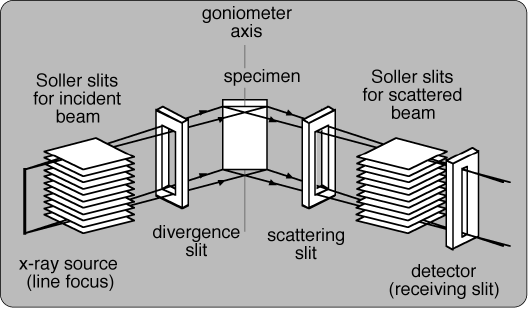
Takashi IDA/Research/ Introduction
A precise mathematical formula of the instrumental function of Bragg-Brentano diffractometer has been derived (Ida, 1998).
Powder X-ray diffraction peak profile varies on instruments and conditions of measurements. It is necessary to take into account the effects of the instrument correctly, for precise evaluation of structures from powder diffraction data.
Then, how should we consider the effect of the instrument? The observed peak profile is usually considered to be expressed as the convolution of the intrinsic peak profile with the instrumental function.
Since the instrumental function varies on which instrument is used, the instrumental function of an instrument may not be applicable to another instrument. Fortunately, there is a common design widely used for powder diffractometers. It is called as Bragg-Brentano design.

The configuration of the Bragg-Brentano diffractometer is very simple as illustrated above, but the lattice constants can be determined at the precision of five siginificant numbers by using this type of diffractometers. Since Bragg-Brentano diffractometers have been used for a long time, the errors of the insrument have already been studied in detail. It is known that significant deformation of observed diffraction peak profile is caused by
in usual measurement conditions.
The above effects are modelled through analytic geometry.
Since the CuKα line is usually used as the x-ray source in powder diffractometry, the most significant effect of the instrument is the splitting of each diffraction peak into Kα1 and Kα2 lines. More precisely, the effects of the x-ray having slightly different wavelength from the peak wavelength can be expressed as the following instrumental function.
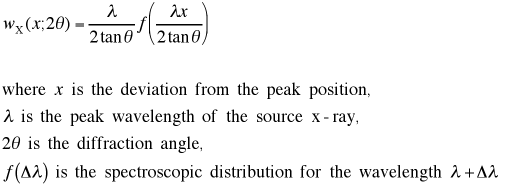 .
.
If both the incident and diffracted x-ray beams are horizontal in the above figure, the diffraction angle should coincide with the goniometer angle. However, the diffraction and the goniometer angles should be different, when the direction of the beam is deviated from the horizontal plane, along the axial direction, in other words. Even though Soller slits, which are stacking of metal foils, are used in the Bragg-Brentano diffractometer in order to reduce the effects of the deviation, the effects of residual divergenc along the axial direction cause aberration. It has been found that the axial divergence aberration restricted by a couple of Soller slits can be expressed by the following mathematical formula derived from second-order Taylor expansion about the axial deviation of the incident and diffracted beams. (The derivation of the formula is explained in a PDF file (167kB) in Japanese.)
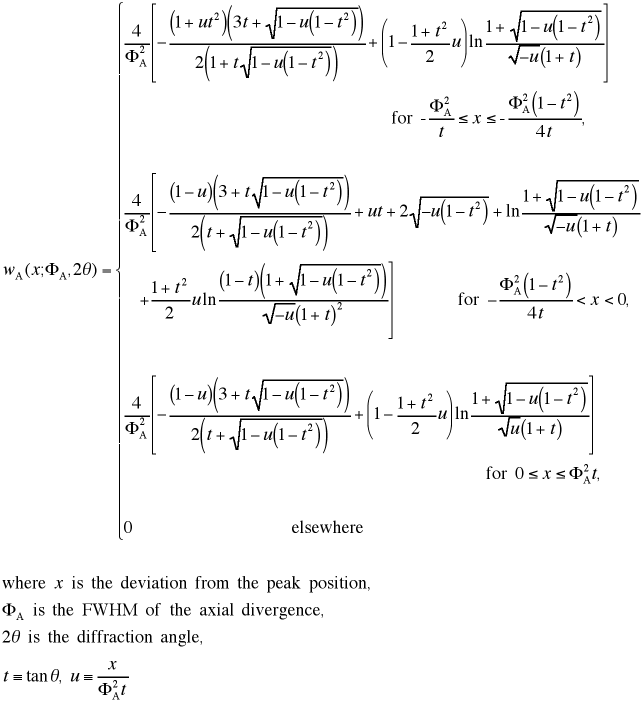
An approximate formula for the axial aberration function,
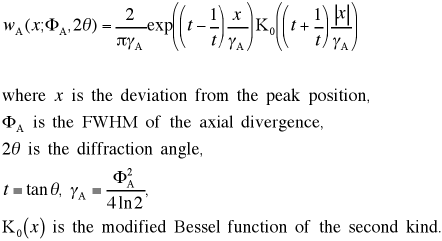
has also been derived (Ida, 1998). The formula includes a special function called as the modified Bessel function of the second kind, but it is not difficult to be numerically evaluated using a computer (Press et al., 1986). The instrumental function evaluated by the approximate formula is very colse to that evaluated by the more precise formula.
If the specimen face has the same curvature with the diffraction circle, the diffraction angle will be unchanged wherever the reflection occurs on the sample face. An aberration is caused by the flat shape of practical specimens. It means that the real diffraction angles for the reflections at the central and edge points of the sample face should be different. The aberration is called as flat-specimen aberration. The formula of the flat-specimen aberration is expressed by (Ida & Kimura, 1999a)
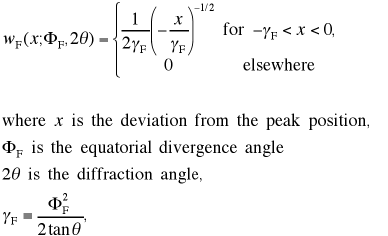
This effect strongly depends on the sample to be measured. Contribution of the reflection at a finite depth of the sample becomes significant for the sample with high-transparency, especially organic materials for example. The instrumental function for this effect is given by (Ida & Kimura, 1999b).

The linear absorption coefficient can be evaluated from themass attenuation coefficient listed in "International Tables for Crystallography, Vol. C" and the bulk density of the specimen.
Therefore, the bulk density of the specimen should always be evaluated before the measurement using a Bragg-Brentano diffractometer. It only requires measurement of weight of sample assuming that the inner volume of the specimen holder is known. The values of the measurements can be critically different, whether the bulk density data are available.
The peak profile is also affected by the finite size of x-ray source and receiving slit, but thouse effects are not discussed here, because it is not difficult to derive the formulas for these effects.
The total instrumental function is expressed as multiple convolution of aberration function. The precise instrumental function of widely used Bragg-Brentano powder diffractometers has been obtained. The method to calculate the convolution is explained in another page.
It should be noted that Finger et al. (1994) has suggested that the instrumental function proposed by van Laar & Yelon (1984) for a neutron diffractometer can also be used for Bragg-Brentano diffractometers. However, it seems difficult to justify the application of van Laar & Yelon model or a variant model by Finger et al. to the data measured with a Bragg-Brentano diffractometer, because the assumed geometry of the optics is quite different. Please be careful to apply the formula proposed by Finger et al., though it is often implemented in a Rietveld program partly because the source codes written in different computer language are publicated.
"A correction for powder diffraction peak asymmetry due to axial divergence", L. W. Finger, D. E. Cox and A. P. Jephcoat, J. Appl. Cryst., 27, 892-900 (1994).
"Formula for the asymmetric diffraction peak profiles based on double Soller slit geometry", T. Ida, Rev. Sci. Instrum., 69, 2268-2272 (1998).
"Flat-Specimen Effect as a Convolution in Powder Diffractometry with Bragg-Brentano Geometry", T. Ida and K. Kimura, J. Appl. Cryst., 32, 634-640 (1999a).
"Effect of Sample Transparency in Powder Diffractometry with Bragg-Brentano Geometry as a Convolution", T. Ida and K. Kimura, J. Appl. Cryst., 32, 982-991 (1999b).
"The peak in neutron powder diffraction", B. van Laar and W. B. Yelon, J. Appl. Cryst., 17, 47-54 (1984).
W. H. Press, B. P. Flannery, S. A. Teukolsky and W. T. Vetterling, Numerical Recipes. Cambridge Univ. Press. (1986).
October 3, 2008